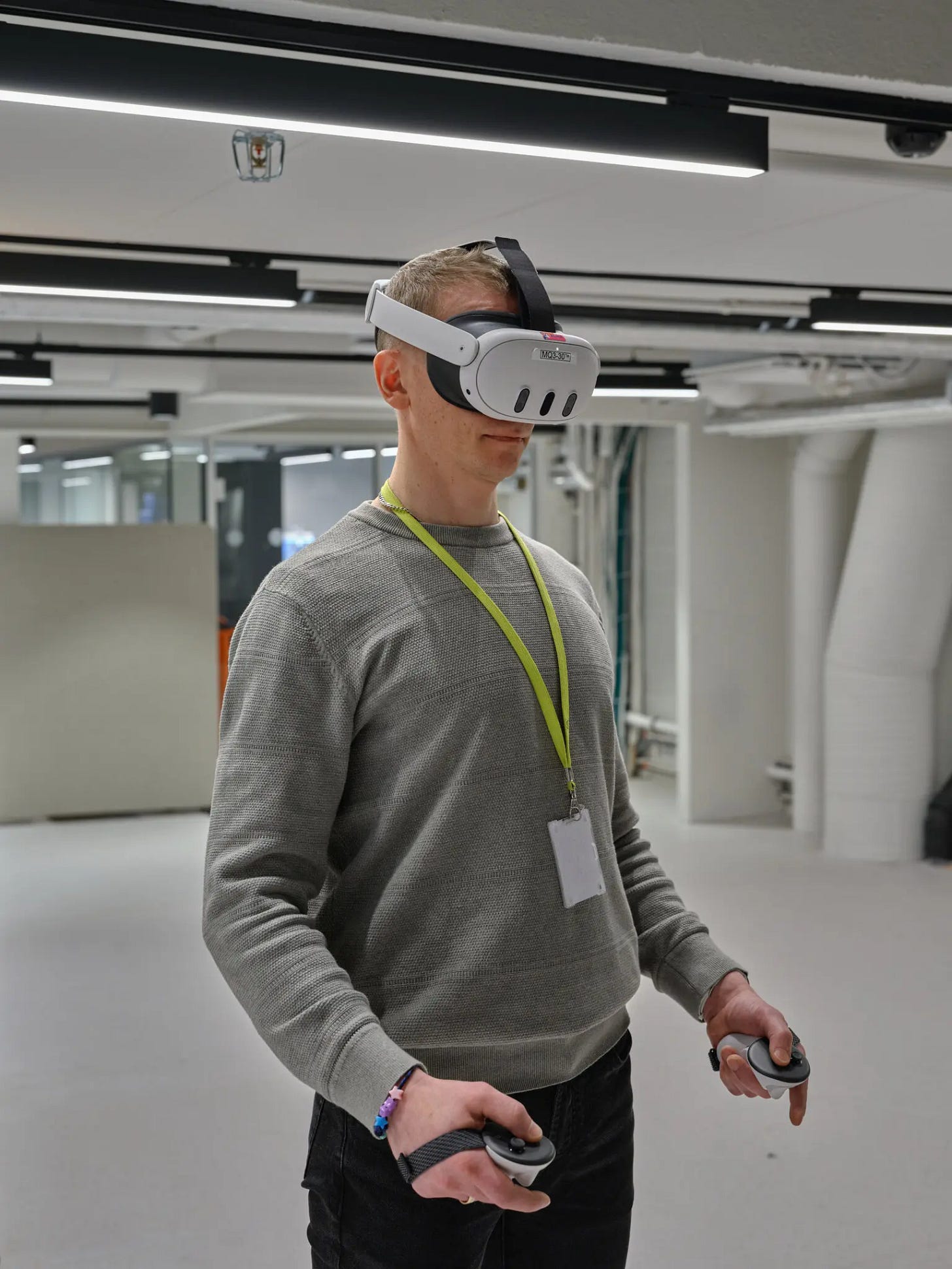Weekly Groundings are published every Friday to highlight the most interesting news, links, and writing I investigated during the past week. They are designed to ground your thinking in the midst of media overload and contribute to Handful of Earth’s broader framework. Please subscribe if you’d like to receive these posts directly in your inbox.
If you’re already subscribed and want to help the publication grow, consider sharing Handful of Earth with a friend.
“The Techno-Utopians Who Want to Colonize the Sea”
The New York Times reports on the rise of “seasteading” and other efforts to create long-term housing in the sea: “Rüdiger Koch officially seized the Guinness World Record for the longest time spent living in an underwater fixed habitat.” He spent “a full 120 days spent working, eating, sleeping, drinking and smoking cigars in a room 36 feet below the surface of the Caribbean.”
“Koch spent his career in aerospace engineering; he is also a ‘long-term’ believer and investor in Bitcoin. Now his time is occupied by Ocean Builders, the company that has set up three solar-powered SeaPods, of differing designs, near Linton Bay Marina. It is a partnership between Koch and two other independently wealthy men: Chad Elwartowski, an American Bitcoin enthusiast; and Grant Romundt, a Canadian tech entrepreneur on an ‘anti-aging health-span journey.’”
Romundt lives “on SeaPod Alpha Blue, which makes good on the lifestyle-company approach. It combines the charm of an upscale Manhattan condominium with 360-degree views of the bay and surrounding islands. It features a smart bed, a smart shower, a smart toilet and Ocean Builders’ ‘liquid computer,’ a P.C. immersed in nonconductive oil to protect it from the corrosive sea air. You can stream Netflix on a wall-mounted 43-inch TV; when I was there, the company was testing a drone for food deliveries from the marina.”
“The Tactics Elon Musk Uses to Manage His ‘Legion’ of Babies—and Their Mothers”
While some techno-utopians seek to colonize the sea, others, led by Elon Musk, prefer space. The Wall Street Journal reports: “Musk has had at least 14 children with four women, including the pop musician Grimes and Shivon Zilis, an executive at his brain computer company Neuralink. Multiple sources close to the tech entrepreneur said they believe the true number of Musk’s children is much higher than publicly known… Musk’s baby-making project is relevant to his ambition for NASA, which he wants to move faster to go to Mars. He said on X that making people multiplanetary is ‘critical to ensuring the long-term survival of humanity and all life as we know it.’”
The report continues: “In Musk’s dark view of the world, civilization is under threat because of a declining population. He is driven to correct the historic moment by helping seed the earth with more human beings of high intelligence, according to people familiar with the matter…Musk refers to his offspring as a ‘legion,’ a reference to the ancient military units that could contain thousands of soldiers and were key to extending the reach of the Roman Empire.”
“Speaking to an audience at an investment conference in Saudi Arabia last year, Musk laid out the urgency of the matter. ‘I think for most countries, they should view the birthrate as the single biggest problem they need to solve. If you don’t make new humans, there’s no humanity, and all the policies in the world don’t matter,’ Musk told the crowd over a live video. When the interviewer joked that Musk was doing his part to address the issue, the billionaire agreed. ‘Yes. I am. I mean, you know, you’ve got to walk the talk. So, I do have a lot of kids, and I encourage others to have lots of kids.’ Separately, Musk has said he is concerned about what he called Third World countries having higher birthrates than the U.S. and Europe, a person familiar with the conversation said. One of the most important ways to change these dynamics, he has repeatedly told people close to him, is for educated people to have more children.”
“We've Become Business Partners in the Apocalypse”
At
, explores how retirement portfolios have quite literally invested Americans in the success of ecologically-destructive corporations: “More than half of U.S. households have retirement accounts; that is, rather than cash savings, investments allocated towards buying stocks and other types of financial products. These purchases provide operating funds to businesses, and in return, investors gain the right to sell their stocks in the future. The system operates under the assumption that well-run businesses grow in value over time. The S&P 500, a stock index tracking the largest 500 companies in the United States, grows by an average of 6.8% per year. In this way, everyday people are invested, quite literally, in the growth of capitalism, through monthly monetary contributions. What this means is simple. As the climate crisis accelerates, as the 6th mass extinction spirals further, as chemical pollution reaches record levels day after day, as our overshoot predicament worsens, as more land is paved and more wild places bulldozed, bank accounts continue to rise. We—that is, anyone with a retirement or investment account, and anyone who cheers when the economy booms and groans when it falls—have become business partners in the apocalypse.”Wilbert continues: “This, of course, is only one way to run a society. Most cultures throughout history have nothing at all resembling this system of investment and yet manage to take care of basic needs and well-being. It is possible for human beings to live without destroying the land. And it is profoundly wrong that as they age, the only viable way for many people to not end up destitute and homeless is by investing in capitalism. For the poor, the magnificent bribe is more a latent threat than golden handcuffs. One thing is certain. While the magnificent bribe has been supremely effective, conservative and liberal elites alike are leading us deeper into the ecological apocalypse. Come economic ruin or miracle, our politics must go beyond our pocketbooks.”
“Teachers Worry About Students Using A.I. But They Love It for Themselves”
The New York Times reports on the rapid adoption of artificial intelligence in K-12 classrooms: “As artificial intelligence makes its way into schools, a paradox is emerging. Many educators, concerned about cheating and shortcuts, are trying to limit student use of A.I. At the same time, teachers are increasingly using A.I. tools themselves, both to save time on rote tasks and to outsource some of their most meaningful work, like grading essays and tutoring struggling students. That tension has prompted some difficult ethical questions. For example, is it fair to use A.I. to grade student essays, if you’ve prohibited students from using A.I. to write them?”
The article continues: “Writing is one of the most challenging tasks for students, which is why it is so tempting for some to ask A.I. to do it for them. In turn, A.I. can be useful for teachers who would like to assign more writing, but are limited in their time to grade it. Companies like MagicSchool and Brisk Teaching already offer A.I. products that give instant feedback on student writing. Automated scoring is also happening in high-stakes scenarios — on exams that determine whether students graduate from high school. In 2020, the state of Texas signed a five-year, $391,000,000 contract with the education technology firm Cambium Assessment, in part to deliver automated scoring of student writing.”
“Invasion of the Home Humanoid Robots”
The New York Times reports on the massive amount of research and development funding for humanoid robots designed to perform domestic labor: “Artificial intelligence is already driving cars, writing essays and even writing computer code. Now, humanoids, machines built to look like humans and powered by A.I., are poised to move into our homes so they can help with the daily chores. [Norwegian engineer named Bernt] Børnich is chief executive and founder of a start-up called 1X. Before the end of the year, his company hopes to put his robot, Neo, into more than 100 homes in Silicon Valley and elsewhere. His start-up is among the dozens of companies planning to sell humanoids and get them into both homes and businesses. Investors have poured $7.2 billion into more than 50 start-ups since 2015, according to PitchBook, a research firm that tracks the tech industry. The humanoid frenzy reached a new peak last year, when investments topped $1.6 billion. And that did not include the billions that Elon Musk and Tesla, his electric car company, are pumping into Optimus, a humanoid they began building in 2021.”
Despite all of this money, these robots are still highly ineffective: “Even when controlled by humans, Neo might drop a cup or struggle to find the right angle as it tries to toss an empty bottle into a garbage can under a sink. Though humanoids have improved by leaps and bounds over the past decade, they are still not as nimble as humans. Neo, for instance, cannot raise its arms above its head. For the uninitiated, Neo can also feel a little creepy, like anything else that seems partly human and partly not. Talking to it is particularly strange, given that you are really talking to a remote technician. It’s like talking to a ventriloquist’s dummy…Soon, Neo began cleaning the towering windows on the side of the house. Then, as I turned back to Mr. Børnich, I heard a crash on the kitchen floor. After an electrical malfunction, Neo had fallen over backward—fainting dead away.”
The article concludes: “Will people let this machine into their homes? How quickly will its skills improve? Can it free people from their daily chores? These questions cannot yet be answered. But Mr. Børnich is pressing forward. ‘There are a lot of people like me,’ he said. ‘They’ve dreamed of having something like this in their home since they were a kid.’”

“The Anthropological Aura”
meditates on the uniqueness of the human being at : “Here’s the connection I want to draw between the artwork’s withering aura under the conditions of modern media technologies and the diminishing status of the human being relative to machines: Just as a work of art is more than a bundle of features which might be reproduced by media technologies, so the human being is more than a bundle of capacities which might be imitated by algorithms. The reproduction of an artwork, no matter how perfect, is a reproduction of the features of the original, and nothing more; so, too, the algorithmic emulation of human beings, no matter how effective, is an emulation of the capabilities of human beings, and nothing more. In both cases, what must remain unduplicated is that portion of the existence of the original which, by its very nature, resists the mimicry and appropriation which can be accomplished by mechanical or algorithmic reproduction: namely, the presence of the original in the place where it is. Like a work of art, I want to suggest, we too represent a unique presence in the world which is different from and not reducible to the functions, however sophisticated, which we are able to perform.”Anderson continues: “For lack of a better term, I will call this the anthropological aura: It names the irreducible authenticity of human being-in-the-world…Just as, when we visit a work of art in a museum, we are following an intuition that there is something distinctive about the original which is borne by none of its reproductions, when we prefer to interact with a real person instead of a chatbot, we are likewise following an intuition that there is something distinctive about human beings which is shared by no digital simulation. All else being equal, the reason we prefer to interact with a real person rather than with a perfectly competent machine is at least partly the same as the reason we prefer to view an original painting rather than even the most impeccable copy: only the original has the power to involve us in a genuine encounter with a singular other, and thus to make a claim upon us by addressing us from out of its unique existence as the object that it is.”
“To perceive the aura, whether of a work of art or of another person, is to invest it with a power to implicate oneself in its own passage through time and space, just as it is to allow it to become implicated in our own. It is the crossing of two threads—two independent stories, as it were—which intersect each other and share a moment of mutual encounter. This immediacy of contact between two unique presences is what media technologies—photographs and chatbots alike—must always suppress, because reproduction creates only the semblance of contact. The duplicate may indeed be technically perfect, or the algorithm entirely competent—its attributes may even surpass those of the original in scope or quantity. But multiplied or enhanced features, in their multiplicity, must always leave behind whatever is singular in the original, whether or not it continues to claim our attention, let alone anything approaching reverence.”
What grounded your thinking this week? Share in the comments.







Thought provoking as always. Thanks for the share. 🙏🏼
Thanks for sharing, Vincent! Also, I had missed some of these New York Times articles, so I appreciate your pointing them out. Will definitely check these out this weekend.